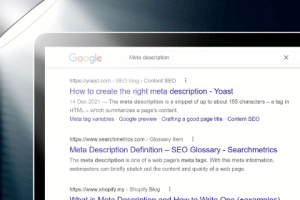A conversion rate in online marketing is the ratio of total visitors to visitors who take desired actions. Successful conversions are measured differently by internet businesses depending on the nature of their business and their goals. Increasing conversion for an online publisher might be submitting a form on a subscription page, whereas an online retailer might measure their conversion rate by the number of clicks on the “Add to Cart” button. Many methods are used by internet businesses in every industry to improve a conversion rate because a higher conversion rate typically translates to a higher return on investment.
What are Conversion Rates?
Conversion rates are calculated by dividing the total number of ad interactions that can be tracked to a conversion during the same period by the number of conversions. The average landing page conversion rate across industries is 2.35 percent, but the top 25% convert at 5.31 percent or higher. Ideally, you want to be in the top 10% of landing pages, which have a conversion rate of 11.45 percent or higher.
Importance of Conversion Rate
Conversions enable businesses to distinguish between visitors who are interested in their products and those who are not; a visitor who takes the desired action becomes a lead. Conversions can also assist businesses in determining issues with their website or marketing funnels. Conversion rate optimization is important because it allows you to reduce customer acquisition costs by extracting more value from existing visitors and users. You can increase revenue per visitor, acquire more customers, and grow your business by optimizing your conversion rate.
Conversion Rate Optimization (CRO)
Conversion rate optimization (CRO) is the practice of increasing the percentage of website visitors who take the desired action. Purchase of a product, clicking ‘add to cart,’ signing up for a service, filling out a form, or clicking on a link are all examples of desired actions. CRO typically entails brainstorming ideas for improving elements of your website or app and then validating those hypotheses through A/B testing and multivariate testing.
Top Tips to Boost, Improve, and Increase Conversion Rate
Many websites have the problem of being either a graphic design masterpiece to display your designer’s skills or a hastily thrown-together afterthought in a rush to launch your business. The true goal of your website is to establish and offer a customer-attractive platform that will move you from interesting to a success. So how to increase conversion rate? Follow these tips below:
1. Lay the groundwork for your website for a good conversion rate.
Any website must have a solid basis. There’s no point in painting the walls if your house was built on quicksand. A website is in the same boat. Visitors who come to your website for a second and then leave are unlikely to convert. Your website should contain and offer the following features to get things off to a great start:
A bold and appealing UX design
If you want to persuade potential customers that you’re serious about your business, you need to present a professional image on the internet. This necessitates having a professionally designed website, or one that appears to be professionally made at the very least. If you run a brick-and-mortar business, you wouldn’t allow a stranger to paint your storefront. Because it’s so important, you’d want to make sure it was done right. Your website, too, might need a lick of paint. Isn’t it true that you never get another chance to make a first impression? According to ConversionXL, design accounts for 94 percent of first impressions. Check to see whether your design is up to UX snuff! Like a well-oiled machine, keep your website in good shape.
A website, like a fine-tuned car, requires regular maintenance and tuning to run effectively and without issues. Many of the matters you do to keep a website running add and have an impact on your visitors, even if it doesn’t appear so. Consider the following scenario: your online store is unavailable for one hour. What would you do in this situation? Some examples of good website upkeep are as follows:
- It’s critical to keep your software up to date (in the case of WordPress, this means updating plugins, themes, and WordPress itself)
- Use a content delivery network (CDN) to keep your website up and running rapidly so you don’t lose customers before they even get there.
- Adding site security to keep hackers at bay while keeping your website up and running.
Make it easy to locate the most crucial information
Here’s where your sidebar and footer navigation and links come in handy. Make sure the most important pages on your site are easily accessible to enhance website conversion. Your contact page, product or service pages, and any other pages that are crucial to your business’s income (or leads) generation must be exceedingly easy to find. Don’t assume that someone will go hunting with you. It’s a business, not a game of hiding and seeks. As a result, make it as easy as possible for your visitors to get in touch with you and make a purchase. Take a look at OptinMonster’s navigation menu as an example: As you can see, everything about OptinMonster is simply accessible, from its feature list to its pricing information to its blog.
Many of the difficulties described above may not appear to have anything to do with conversion, but consider this: if your website doesn’t look decent or load quickly, you’ll lose potential customers before they’ve even had a chance to learn more about you. As a result, the foundation of your website is vital to your online success.
Focus for Call to Action
A call to action (CTA) is a button or link that directs visitors to take a specific action, such as “Add to Cart” or “Register Now.” Experimenting with different CTAs, not only the position on the page but also new CTA text or icon on the button, can potentially improve conversion rates. Optimizely was able to increase conversion rates on the homepage by 27 percent by changing the call to action button text from “Get Started” to “Test It Out” in one experiment. The hypothesis was that action words would perform better than non-action words and that less process-oriented wording would perform better. After observing a significant improvement in conversion rate from “Test It Out,” we concluded that this language made it clear that the user could try it right away without going through a lengthy process. “Get Started” seemed to present a more hands-on, involved process to us.
Landing Page
Landing pages typically accomplish three tasks:
- They inform the user about what your business has to offer.
- They pique your interest in their offer, often by explaining what makes your company unique.
- They make it simple and clear for the user to take advantage of your offer (i.e., “convert”).
In other words, landing pages provide enough information to entice users to convert while also gently guiding them in that direction. This includes your content, layout, style, and functionality. A page with too much content, for example, may confuse users, whereas a page with insufficient or the wrong kind of content may not motivate them to convert. Experiment with page element positioning. Change up the text and images. Examine the effects of making stylistic changes to page elements. Consider questions such as, “Does the text field have to be long?” Should the call to action be a different color? Finally, experiment with different user experiences and functionality.
2. Guide visitors toward your goals.
Different visitors act in different ways. Organic visitors, for example, spend more time on websites, view more pages, and have lower bounce rates than visitors from paid campaigns. Similarly, returning visitors browse websites in a different way than new visitors. Your testing parameters should account for these behavioral differences. Create tests that are targeted at the right people.
Your website exists to assist visitors in accomplishing your core business goals. Keep a record of it. Make a note of it in your head. This is the key to your internet success. Sure, your site should look great and work properly, but you should also think about conversion-focused design. The idea is straightforward: keep in mind that you’re trying to drive visitors to a certain goal (or goals) on your website. Those goals will vary depending on who you are and your website-type versions should be prioritized if you want to attain online conversion success. Listed below are a few examples:
- Convincing visitors to subscribe to your email list (blogs, businesses, etc)
- Enticing visitors to sign up for a free trial (SaaS—online tools, memberships, and other similar services).
- Encouraging visitors to complete a contact form (services or coaching businesses)
So, now that you know what goals you may have, how do you get people to follow you to them? The most straightforward technique is to employ a call to action. This normally comprises of a headline, some supporting text, and a button that takes readers to your intended location (a page, a form, etc). Calls to action can be placed in a variety of places on your website, including strategic spots (such as when a visitor is considering something related to your goal) and more common spots like:
- on every page at the top
- the column on the right
- the final result
- in the form of a pop-up window
Because your homepage is likely to be the most visited page on your site, it’s one of the best places to catch people’s attention. Because it features your hero, this area is commonly referred to as your site’s hero section. It’s not Superman—it’s a product, a service, or a bargain! One of the better examples of this on a blog is Derek Halpern’s Social Triggers. He’s been promoting this idea for quite some time, and his most current iteration is fairly simple. As you can see below, he’s dead set on getting you on his email list:
Another excellent example of a well-placed call to action is Pat Flynn’s about page. He knows that individuals who are reading about him are interested in learning more, so he encourages them to join his email list so that he can keep in touch: These examples are oriented toward growing your email list, but you can easily adapt the concepts to your own company goals.
Multiple Page Elements
Remember why you’re testing: you want to achieve a specific goal or goals. Many factors can influence whether you achieve your goal of increasing views, sign-ups, leads, revenue, downloads, or a combination of these. Tracking multiple elements on the pages you’re testing allows you to see how your tests affect the various ways a visitor can achieve the goal. You will be able to learn not only which experience was better by tracking multiple elements, but also why it was better for your site visitors.
The company conducts A/B tests in the hopes of increasing the number of visitors who convert into leads. They track clicks on all three lead-generation sources to see if and how any changes affect them. Perhaps promoting the 30-day free trial detracts from visitors who become leads after watching the video. Tracking clicks on both buttons will provide a complete picture of how to optimize the page for the ultimate goal of increasing leads.
3. Increase and keep your relationship with the search engines favorable.
Many people mistakenly believe that SEO is primarily focused on Google (and maybe Bing). That used to be true, but in recent years, search algorithms have improved so much that the tables have been entirely turned. When it comes to SEO today, it’s all about your visitors. It’s also a great way to improve sales! As a result, we also mean “keeping your visitors/customers happy” when we say “keeping search engines happy.” Numerous factors go into making your search engine fantasies a reality on a website, but they are all worthwhile in the end. We touched on a few of them in the last part when we discussed the essentials of your website, but now it’s time to dig a little deeper.
A mobile-first approach
Mobile search overtook desktop search in 2015. When Google launched its mobile website tester, it was clear that mobile is important for search. This test will tell you right away if your site will look great and function properly on a mobile device. So, if you’re on the fence regarding your website, give it a shot right now. If the results are negative/red (and you’ve checked it on multiple phones), have this problem rectified right away.
Make On-Page SEO adjustments to your pages
Even if you’re not an SEO expert, learning how to optimize your website for search engine traffic is worth an hour or two of your time. This is known as on-page SEO, and Brian Dean of Backlinko will show you how to design a perfectly optimized page in this piece. This may appear to be a little issue not deserving your attention. Simple changes like these, on the other hand, have seen companies achieve a 20 percent spike in traffic in just one month. You’re doing yourself a disservice if you don’t pay attention to on-page SEO.
4. Increase presence and create a mailing list.
Your email list, in addition to your website or online store, is one of your most significant business assets. This is because it gives you direct access to the inboxes of people who have given you permission to email them. Email is also one of the most effective sales mediums accessible. Expanding your email list and putting out an email newsletter is always an excellent idea, even if you’re experiencing a lot of success with your business, website, or offline networking. Did you know you can use SeedProd to create a “coming soon” page on your WordPress site to begin developing your email list before it goes live? When you know your site will be down but don’t want your lead generation efforts to be impeded, there’s also a maintenance mode option.
There are many ways to improve your subscriber base, but one of the most straightforward is to establish a simple offer for your future customers. This could involve a wide range of items, including:
- A simple-to-follow the checklist
- A step-by-step guide
- A list of references
- A quick video demonstration
Simply make sure that your offer is beneficial, practical, and answers a problem that the majority of your potential customers will face. Always leave them wanting a little more, and encourage them to contact you if they need more help. After all, “more assistance” could indicate that they employ your services or buy your items. Another tip for effectively using an email list to grow your customer base is to update it regularly with new information. This can be demonstrated through a weekly newsletter, previous blog entries, useful advice, and case studies (all thrown into a handy autoresponder series).
The purpose is to build trust, demonstrate competence, and demonstrate that you are aware of your customer’s concerns. They’ll ultimately find their way back to your front door. In so many respects, marketing automation is a game-changer. Check out our article on email marketing automation tools to find the right solutions to make it simple.
Social Proof
Your reputation and online presence, without a doubt, have an impact on your conversion rate. That is why social proof should be included on your website. You can include a link to Yelp or any other directory page where customers have left reviews. You should also include testimonials and reviews on your website so that visitors do not have to go to a third-party site. It should be clear that your customers had a good time using your product or service. Your conversion rate will suffer if it is not.
Track Interaction
It will be difficult to improve your conversion rate if you do not understand how users interact with your website. But how can you tell where visitors are getting confused? You can view screen recordings of users on your website using website analysis tools. You’ll be able to see what they click on, if they skip over an offer, or if they abandon a form in the middle. These tools should also include heat maps of your site so you can see which elements stand out and draw the eye.
Live Chat
Many visitors are considering purchasing your service but are undecided. They have a nagging doubt or question that prevents them from taking the final step. Live chat tools are ideal for assisting these people. Live chat tools, like pop-ups, are simple to integrate into any website and provide an immediate boost to your conversion rates.
Suggestions to Increase Conversion Rates
Fortunately, several tools can help you grow your email list. OptinMonster is a terrific and cost-effective alternative. With features like Exit-Intent Technology, the Floating Bar, a drag-and-drop form builder, MonsterLinks, and Mobile Templates, OptinMonster offers a solution for any list-building need. The second step is to find an email management system, which is typically available online. You’ll quickly find yourself on the email bad list if you don’t keep it in your contacts. Constant Contact is a reputable company that comes highly recommended. Do you wish you had a wider range of choices? Consider the following Mailchimp alternatives and SMTP providers.
You’ll also need a place to put your website. Bluehost is a well-known website hosting service, however, there are other Bluehost alternatives if you’re looking for something else in 2019. It’s time to improve the conversion rate of your website. You’ve got everything you need to grow your business and attract more customers; now it’s time to put it all together and convert your website… It is best to have more than one. Begin by identifying the lowest-hanging fruit for your website/business and working your way up. Increased site performance, the addition of a contact form, and the use of appealing calls to action are all examples of this. Then go on to the next most important change you believe will help you earn more money.
Take things one step at a time, constantly seeking to develop and discover new ways to make your website better, faster, more goal-oriented, and customer-friendly! Now get out there and get those clients! If you are looking for guidance contact mach1webistes for our affordable website services that are design to increase conversions.





